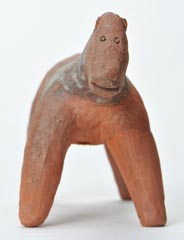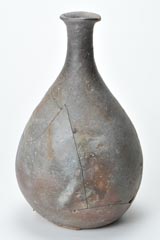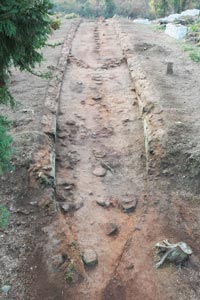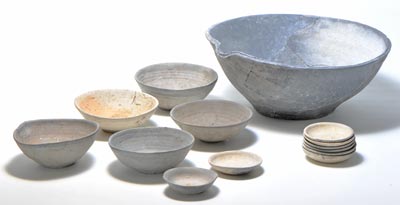Bizen Ware Kiln Site Group:
Changes from the Heian to Early Modern periods in the conditions of
production, known from excavations.
Bizen Ware Kiln Site Group, Bizen City, Okayama Prefecture
From Sue ware production to Bizen ware
The Bizen Ware Kiln Site Group consists of kiln remains from the Ancient to Early Modern periods in the Inbe region, facing the Inland Sea in the southern part of the city of Bizen. Ceramic mortars and large vases hardened through long firing in large-scale kilns were used as daily utensils all over western Japan from the end of the Kamakura period for their robustness, and the unique rustic simplicity of the vessels' surface was prized by many tea ceremony enthusiasts from the Momoyama period on.
The kiln remains have a broad area of distribution, surrounded by a mountainous region with hills exceeding 400 m in elevation to the north, lying near the Inland Sea to the east, and extending over the Inbe foothills, a narrow plain through which low hills run in the south. On the southern side of Inbe is the Oku Ancient Kiln Site Group, where Sue ware was produced from the Kofun to the Late Heian (twelfth century) periods, and as if in response to its cessation, the making of Bizen ware at Inbe then began.
Kiln sites were dispersed among the hills in the Medieval era, but from the start of the Muromachi period (fourteenth century) they began to assemble towards the plain, and by the end of that period were integrated into three ōgama (large kilns), the Inbe Minami Ōgama, Kita Ōgama, and Nishi Ōgama—to the south, north, and west, respectively—and Bizen ware production continued unbroken at these locations until the Meiji era.
Investigations at Minami Ōgama, Nishi Ōgama
Excavation of Inbe Minami Ōgama ascertained an extremely large kiln of the Edo period, plus a monohara (waste pile, where failures and kiln furniture were discarded) reaching several meters deep. Kiln remains from the Azuchi-Momoyama and Edo periods were detected in the vicinity, and tea ceremony utensils such as kensui (wastewater container), plus a rare ceramic item in the shape of a horse were found.
Meanwhile, in the environs of Nishi Ōgama, the Iōzan Tōroku Kiln Site Group No. 2 kiln from the end of the Heian period was excavated, and items such as flat roof tiles, deep and shallow bowls, and small plates were recovered.
Through excavations such as these, aspects of Bizen ware production including the structure of kilns is becoming known from the Heian up to the Meiji periods. (Ishii Kei)
(principal artifacts, Bizen Ware Kiln Site Group)


Ceramic horse
(Central Kiln, Inbe Minami Ōgama)
Azuchi-Momoyama period (last quarter of the sixteenth century).
Length: 19.2 cm; width: 6.8 cm; height: 12.1 cm.
Both eyes and the mouth are incised on the face, and a piece of clay applied as the male sex organ. The expression is realistic, with a hole being poked with some kind of stick for the anus, and the mane indicated by incised lines. The right foreleg has a hole at the end, and it is thought that a string was passed through it. Clay and ceramic horses are said to have originated from the practice of offering live animals to the deities, but at this period there are no other examples of Bizen ware horses, and as it differs from Edo period trends in Bizen ware handiwork, this horse is an enigma.

Sake bottle
(East No. 3 Kiln, Inbe Minami Ōgama)
Azuchi-Momoyama period (last quarter of the sixteenth century).
Height: 26.7 cm; diameter at the base: 10.3 cm.
A large teardrop-shaped sake bottle, with a mark in the shape of } on the neck (not shown in this photo). It is shaped on a wheel from coiled clay, and finished by shaving the body with a spatula. If it had been fired without breaking, it may well have been passed down to the present day as a piece of Momoyama period art.

(West No. 1 Kiln, Inbe Minami Ōgama)
Latter part of the Edo period (mid-nineteenth century).
Rim diameter: 3.6 cm; vessel height: 27.8 cm.
In the latter half of the Edo period, square sake bottles were a main commodity for Bizen ware, and were used in great amounts as containers for a medicinal liquor made in Tomonoura (now in Fukuyama city, Hiroshima prefecture), sold under the brand name Hōmeishu. The body of the bottle was made by fitting together boards of clay, while the top was made by fitting clay boards with a design taken from a mold, and attaching a spout fashioned on a wheel. The body was at times decorated by incising pictures of auspicious plants, geometric designs, or poetry. Made with a combination of manufacturing techniques, this sake bottle can be called the culmination of the craftsman's work.
 Kensui and lid (West No. 1 Kiln, Inbe Minami Ōgama) First half of the Edo period (first quarter of the seventeenth century). Kensui, rim diameter: 13.8 cm; height: 8.6 cm. Lid, diameter: 12.1 cm; height: 4.8 cm. These are a kensui and lid that became failures when the kiln accidentally collapsed during firing. A kensui is a container in the tea ceremony for holding discarded water, such as hot water used for warming the tea cups, and there are a number of types such as this one with an outward flaring rim, or ones with indented portions at the center of the body. The lid does not go with the kensui, but there are a variety of types such as those with ropes of clay knotted in the manner of ribbons or rounded into rings. As ordinary articles of daily life such as vases, cooking pots, and mortars were apparently hardly ever fired at this particular kiln, it may have been one for specially ordered items. |
 Saggar and oil jar (Western Kiln, Inbe Minami Ōgama) Mid-Edo period (end of the seventeenth–start of the eighteenth centuries) Saggar, rim diameter: 10.8 cm; height: 6.3 cm. Oil jar, rim diameter: 2.1 cm; height: 4.6 cm. This oil jar was found still inside its saggar, a container for protecting ceramic products during firing. The oil jar was a container for holding a pomade for dressing the hair, and in addition to items with flattened bodies like this one, there were also round types. Saggars in a cylindrical shape as this item are commonly seen, but there is great variety with box-shaped items, and those with holes opened in the bodies, and among them even very large ones with the height reaching 37 cm. |






